The Role of Amygdala Dysfunction in Predisposing Violent Behavior
VerifiedAdded on 2023/04/11
|6
|932
|95
Essay
AI Summary
This essay explores the correlation between amygdala dysfunction and violent behavior, highlighting research indicating that damage to the prefrontal cortex and abnormalities in the amygdala can lead to increased aggression. It discusses how violent offenders often exhibit higher neural reactions to provocations within their amygdala and striatum. The essay further examines the role of the amygdala in emotional learning, fear response, and its connection to psychiatric disorders and violent tendencies. While the essay acknowledges the progress made in identifying the neurological basis of violence, it emphasizes the need for further research to develop methods for controlling and preventing such behavior, underscoring the importance of understanding brain abnormalities in addressing societal violence.
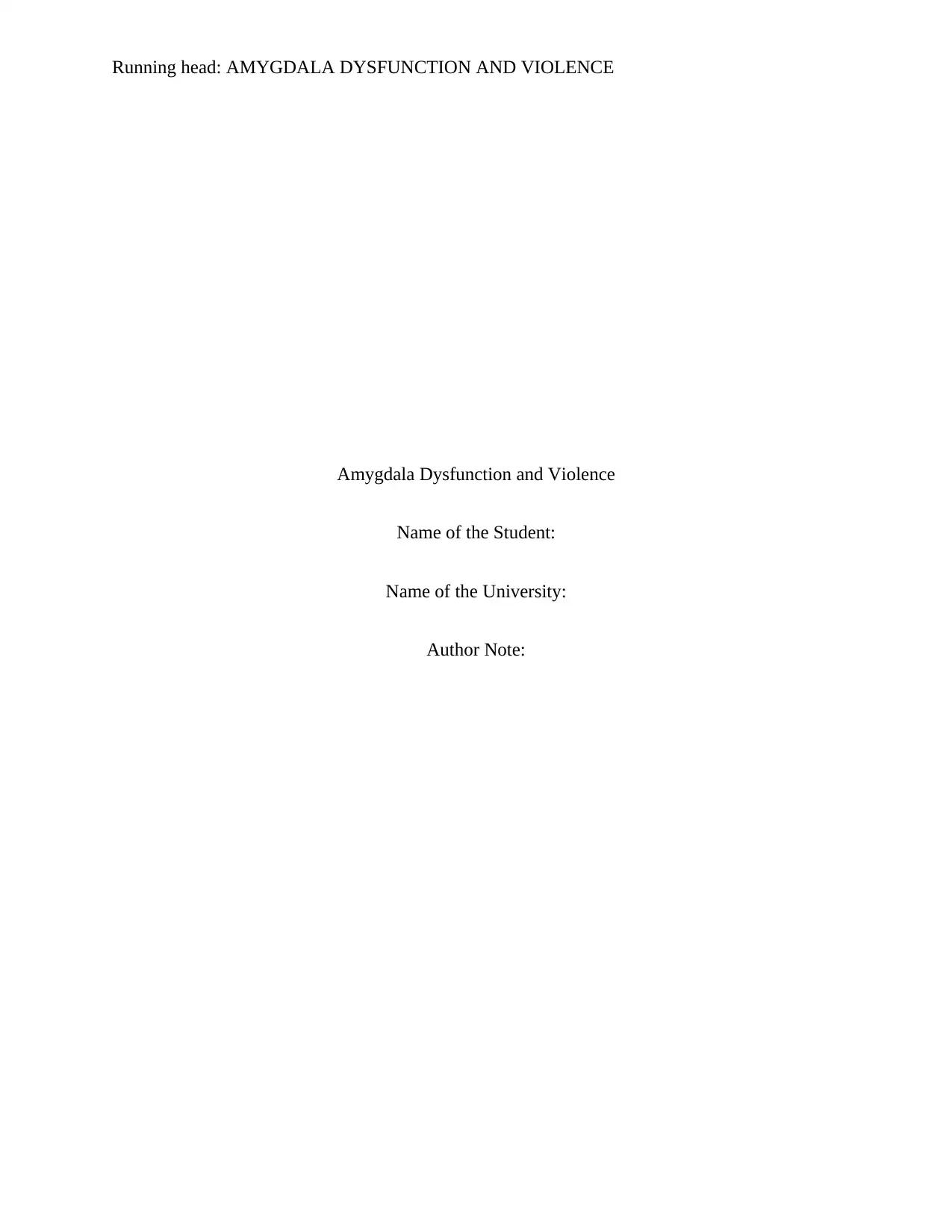
Running head: AMYGDALA DYSFUNCTION AND VIOLENCE
Amygdala Dysfunction and Violence
Name of the Student:
Name of the University:
Author Note:
Amygdala Dysfunction and Violence
Name of the Student:
Name of the University:
Author Note:
Paraphrase This Document
Need a fresh take? Get an instant paraphrase of this document with our AI Paraphraser
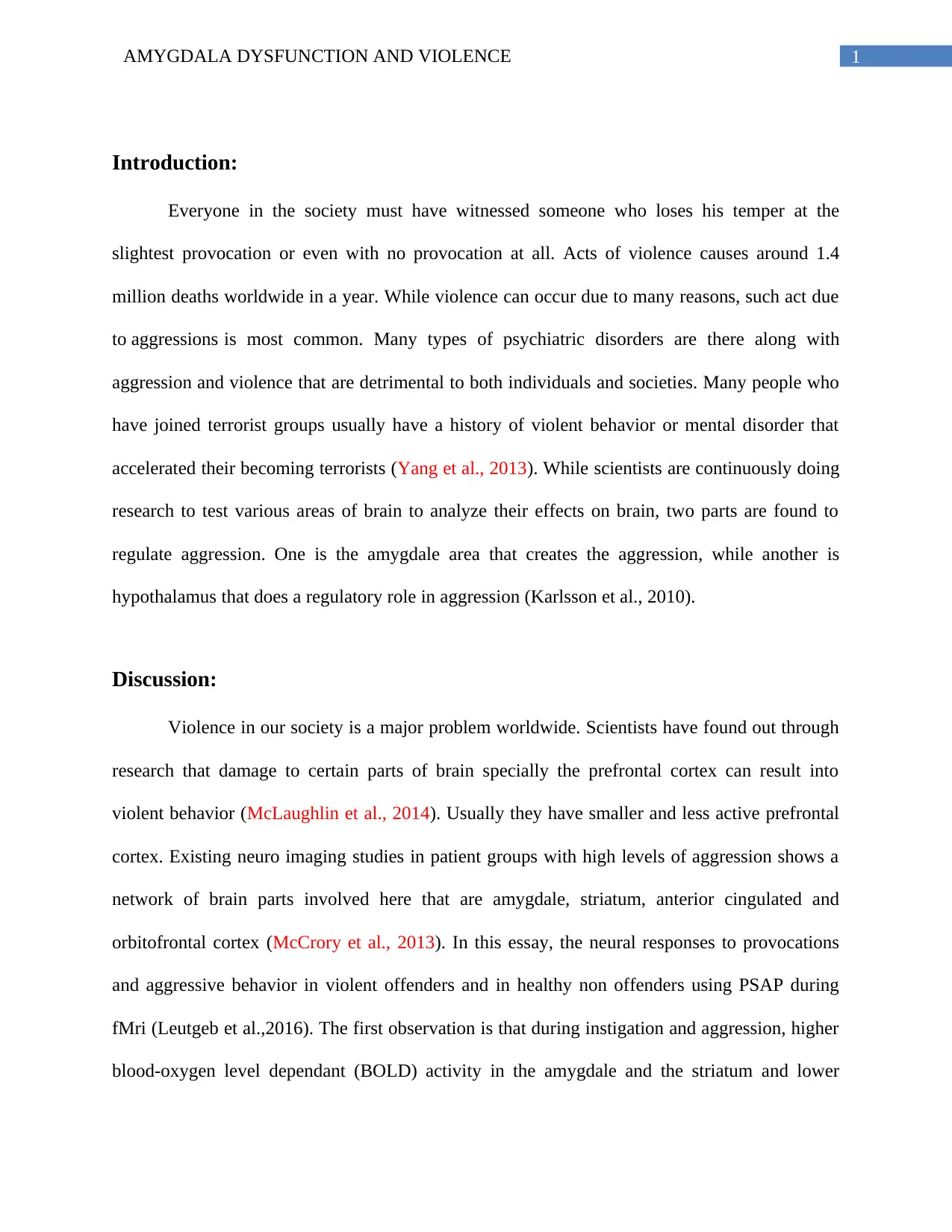
1AMYGDALA DYSFUNCTION AND VIOLENCE
Introduction:
Everyone in the society must have witnessed someone who loses his temper at the
slightest provocation or even with no provocation at all. Acts of violence causes around 1.4
million deaths worldwide in a year. While violence can occur due to many reasons, such act due
to aggressions is most common. Many types of psychiatric disorders are there along with
aggression and violence that are detrimental to both individuals and societies. Many people who
have joined terrorist groups usually have a history of violent behavior or mental disorder that
accelerated their becoming terrorists (Yang et al., 2013). While scientists are continuously doing
research to test various areas of brain to analyze their effects on brain, two parts are found to
regulate aggression. One is the amygdale area that creates the aggression, while another is
hypothalamus that does a regulatory role in aggression (Karlsson et al., 2010).
Discussion:
Violence in our society is a major problem worldwide. Scientists have found out through
research that damage to certain parts of brain specially the prefrontal cortex can result into
violent behavior (McLaughlin et al., 2014). Usually they have smaller and less active prefrontal
cortex. Existing neuro imaging studies in patient groups with high levels of aggression shows a
network of brain parts involved here that are amygdale, striatum, anterior cingulated and
orbitofrontal cortex (McCrory et al., 2013). In this essay, the neural responses to provocations
and aggressive behavior in violent offenders and in healthy non offenders using PSAP during
fMri (Leutgeb et al.,2016). The first observation is that during instigation and aggression, higher
blood-oxygen level dependant (BOLD) activity in the amygdale and the striatum and lower
Introduction:
Everyone in the society must have witnessed someone who loses his temper at the
slightest provocation or even with no provocation at all. Acts of violence causes around 1.4
million deaths worldwide in a year. While violence can occur due to many reasons, such act due
to aggressions is most common. Many types of psychiatric disorders are there along with
aggression and violence that are detrimental to both individuals and societies. Many people who
have joined terrorist groups usually have a history of violent behavior or mental disorder that
accelerated their becoming terrorists (Yang et al., 2013). While scientists are continuously doing
research to test various areas of brain to analyze their effects on brain, two parts are found to
regulate aggression. One is the amygdale area that creates the aggression, while another is
hypothalamus that does a regulatory role in aggression (Karlsson et al., 2010).
Discussion:
Violence in our society is a major problem worldwide. Scientists have found out through
research that damage to certain parts of brain specially the prefrontal cortex can result into
violent behavior (McLaughlin et al., 2014). Usually they have smaller and less active prefrontal
cortex. Existing neuro imaging studies in patient groups with high levels of aggression shows a
network of brain parts involved here that are amygdale, striatum, anterior cingulated and
orbitofrontal cortex (McCrory et al., 2013). In this essay, the neural responses to provocations
and aggressive behavior in violent offenders and in healthy non offenders using PSAP during
fMri (Leutgeb et al.,2016). The first observation is that during instigation and aggression, higher
blood-oxygen level dependant (BOLD) activity in the amygdale and the striatum and lower
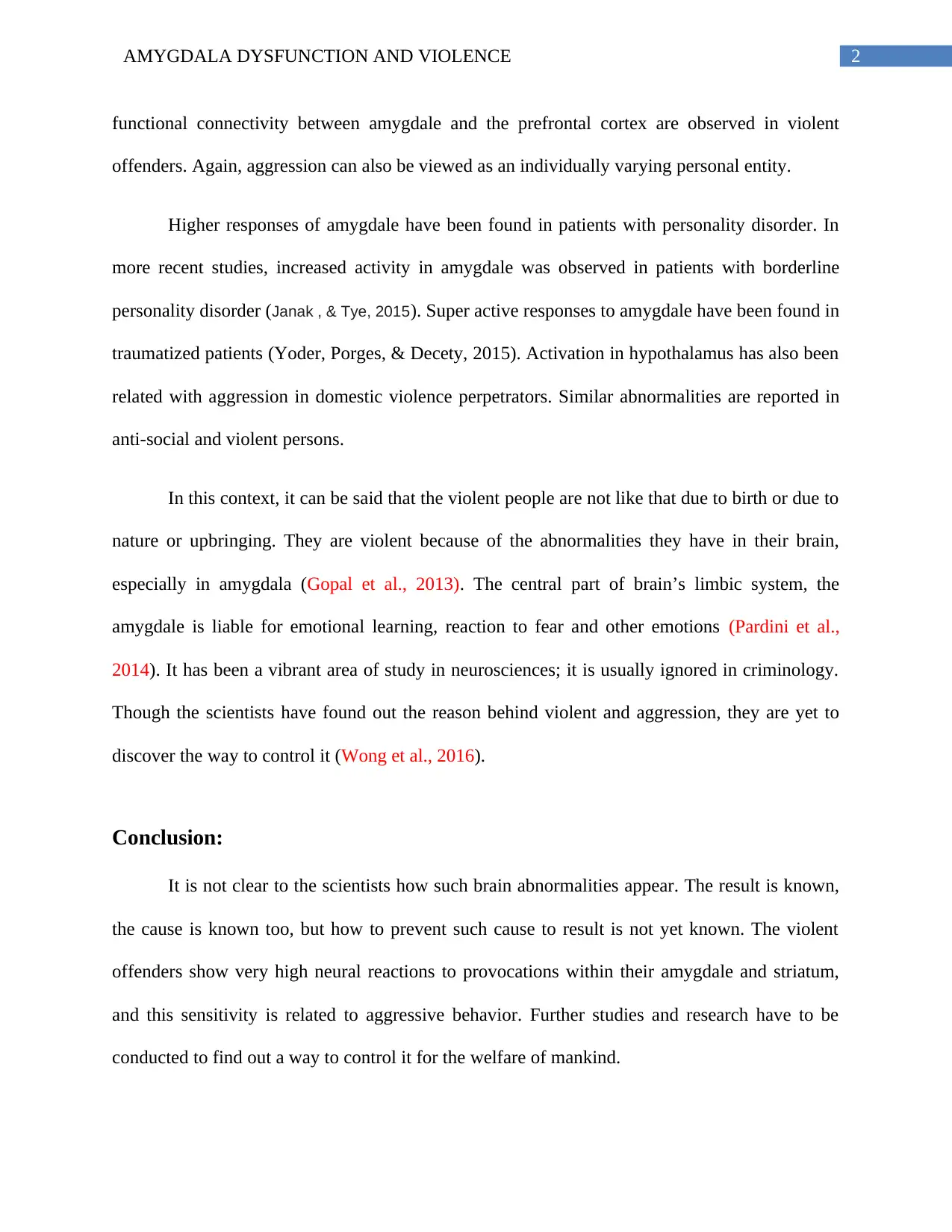
2AMYGDALA DYSFUNCTION AND VIOLENCE
functional connectivity between amygdale and the prefrontal cortex are observed in violent
offenders. Again, aggression can also be viewed as an individually varying personal entity.
Higher responses of amygdale have been found in patients with personality disorder. In
more recent studies, increased activity in amygdale was observed in patients with borderline
personality disorder (Janak , & Tye, 2015). Super active responses to amygdale have been found in
traumatized patients (Yoder, Porges, & Decety, 2015). Activation in hypothalamus has also been
related with aggression in domestic violence perpetrators. Similar abnormalities are reported in
anti-social and violent persons.
In this context, it can be said that the violent people are not like that due to birth or due to
nature or upbringing. They are violent because of the abnormalities they have in their brain,
especially in amygdala (Gopal et al., 2013). The central part of brain’s limbic system, the
amygdale is liable for emotional learning, reaction to fear and other emotions (Pardini et al.,
2014). It has been a vibrant area of study in neurosciences; it is usually ignored in criminology.
Though the scientists have found out the reason behind violent and aggression, they are yet to
discover the way to control it (Wong et al., 2016).
Conclusion:
It is not clear to the scientists how such brain abnormalities appear. The result is known,
the cause is known too, but how to prevent such cause to result is not yet known. The violent
offenders show very high neural reactions to provocations within their amygdale and striatum,
and this sensitivity is related to aggressive behavior. Further studies and research have to be
conducted to find out a way to control it for the welfare of mankind.
functional connectivity between amygdale and the prefrontal cortex are observed in violent
offenders. Again, aggression can also be viewed as an individually varying personal entity.
Higher responses of amygdale have been found in patients with personality disorder. In
more recent studies, increased activity in amygdale was observed in patients with borderline
personality disorder (Janak , & Tye, 2015). Super active responses to amygdale have been found in
traumatized patients (Yoder, Porges, & Decety, 2015). Activation in hypothalamus has also been
related with aggression in domestic violence perpetrators. Similar abnormalities are reported in
anti-social and violent persons.
In this context, it can be said that the violent people are not like that due to birth or due to
nature or upbringing. They are violent because of the abnormalities they have in their brain,
especially in amygdala (Gopal et al., 2013). The central part of brain’s limbic system, the
amygdale is liable for emotional learning, reaction to fear and other emotions (Pardini et al.,
2014). It has been a vibrant area of study in neurosciences; it is usually ignored in criminology.
Though the scientists have found out the reason behind violent and aggression, they are yet to
discover the way to control it (Wong et al., 2016).
Conclusion:
It is not clear to the scientists how such brain abnormalities appear. The result is known,
the cause is known too, but how to prevent such cause to result is not yet known. The violent
offenders show very high neural reactions to provocations within their amygdale and striatum,
and this sensitivity is related to aggressive behavior. Further studies and research have to be
conducted to find out a way to control it for the welfare of mankind.
⊘ This is a preview!⊘
Do you want full access?
Subscribe today to unlock all pages.

Trusted by 1+ million students worldwide

3AMYGDALA DYSFUNCTION AND VIOLENCE
Paraphrase This Document
Need a fresh take? Get an instant paraphrase of this document with our AI Paraphraser
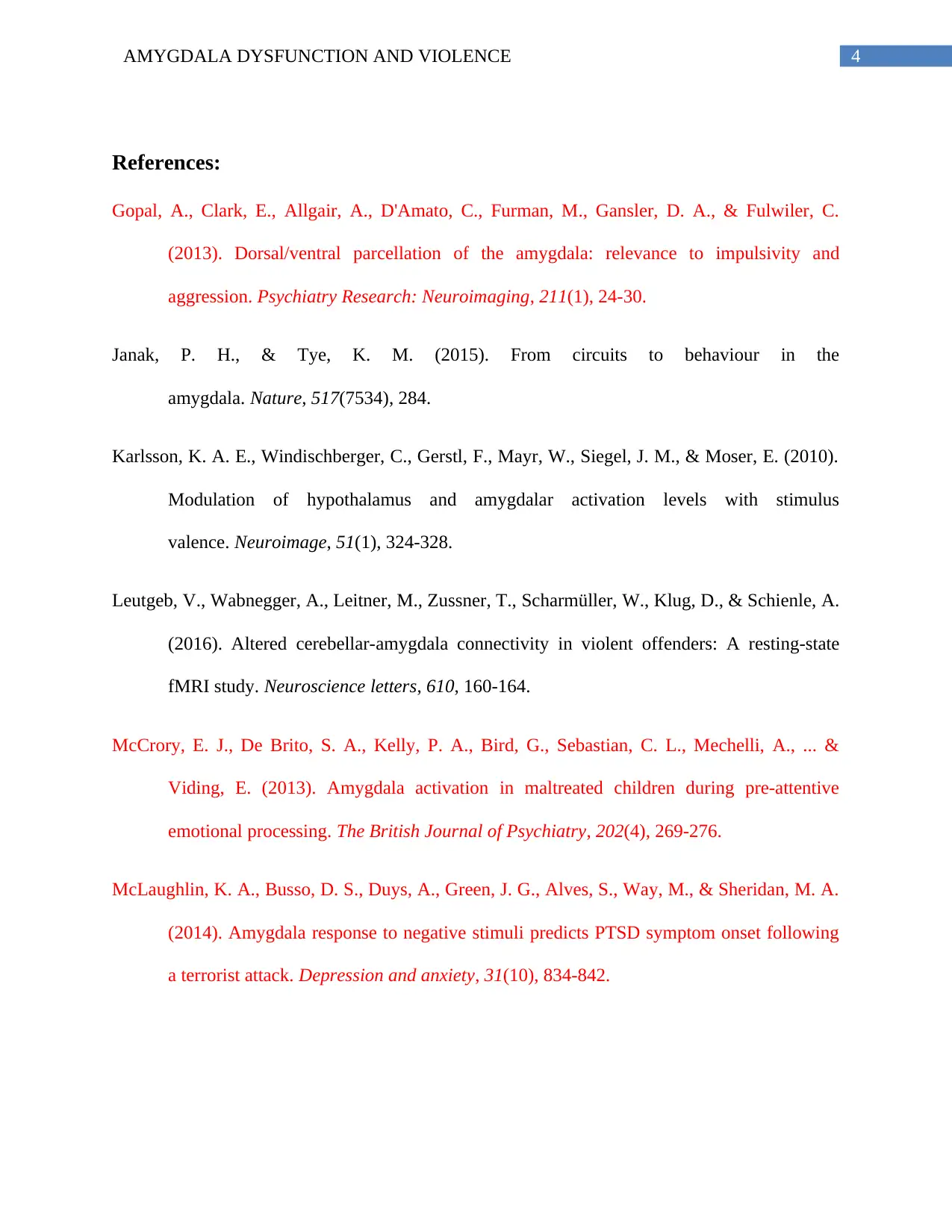
4AMYGDALA DYSFUNCTION AND VIOLENCE
References:
Gopal, A., Clark, E., Allgair, A., D'Amato, C., Furman, M., Gansler, D. A., & Fulwiler, C.
(2013). Dorsal/ventral parcellation of the amygdala: relevance to impulsivity and
aggression. Psychiatry Research: Neuroimaging, 211(1), 24-30.
Janak, P. H., & Tye, K. M. (2015). From circuits to behaviour in the
amygdala. Nature, 517(7534), 284.
Karlsson, K. A. E., Windischberger, C., Gerstl, F., Mayr, W., Siegel, J. M., & Moser, E. (2010).
Modulation of hypothalamus and amygdalar activation levels with stimulus
valence. Neuroimage, 51(1), 324-328.
Leutgeb, V., Wabnegger, A., Leitner, M., Zussner, T., Scharmüller, W., Klug, D., & Schienle, A.
(2016). Altered cerebellar-amygdala connectivity in violent offenders: A resting-state
fMRI study. Neuroscience letters, 610, 160-164.
McCrory, E. J., De Brito, S. A., Kelly, P. A., Bird, G., Sebastian, C. L., Mechelli, A., ... &
Viding, E. (2013). Amygdala activation in maltreated children during pre-attentive
emotional processing. The British Journal of Psychiatry, 202(4), 269-276.
McLaughlin, K. A., Busso, D. S., Duys, A., Green, J. G., Alves, S., Way, M., & Sheridan, M. A.
(2014). Amygdala response to negative stimuli predicts PTSD symptom onset following
a terrorist attack. Depression and anxiety, 31(10), 834-842.
References:
Gopal, A., Clark, E., Allgair, A., D'Amato, C., Furman, M., Gansler, D. A., & Fulwiler, C.
(2013). Dorsal/ventral parcellation of the amygdala: relevance to impulsivity and
aggression. Psychiatry Research: Neuroimaging, 211(1), 24-30.
Janak, P. H., & Tye, K. M. (2015). From circuits to behaviour in the
amygdala. Nature, 517(7534), 284.
Karlsson, K. A. E., Windischberger, C., Gerstl, F., Mayr, W., Siegel, J. M., & Moser, E. (2010).
Modulation of hypothalamus and amygdalar activation levels with stimulus
valence. Neuroimage, 51(1), 324-328.
Leutgeb, V., Wabnegger, A., Leitner, M., Zussner, T., Scharmüller, W., Klug, D., & Schienle, A.
(2016). Altered cerebellar-amygdala connectivity in violent offenders: A resting-state
fMRI study. Neuroscience letters, 610, 160-164.
McCrory, E. J., De Brito, S. A., Kelly, P. A., Bird, G., Sebastian, C. L., Mechelli, A., ... &
Viding, E. (2013). Amygdala activation in maltreated children during pre-attentive
emotional processing. The British Journal of Psychiatry, 202(4), 269-276.
McLaughlin, K. A., Busso, D. S., Duys, A., Green, J. G., Alves, S., Way, M., & Sheridan, M. A.
(2014). Amygdala response to negative stimuli predicts PTSD symptom onset following
a terrorist attack. Depression and anxiety, 31(10), 834-842.
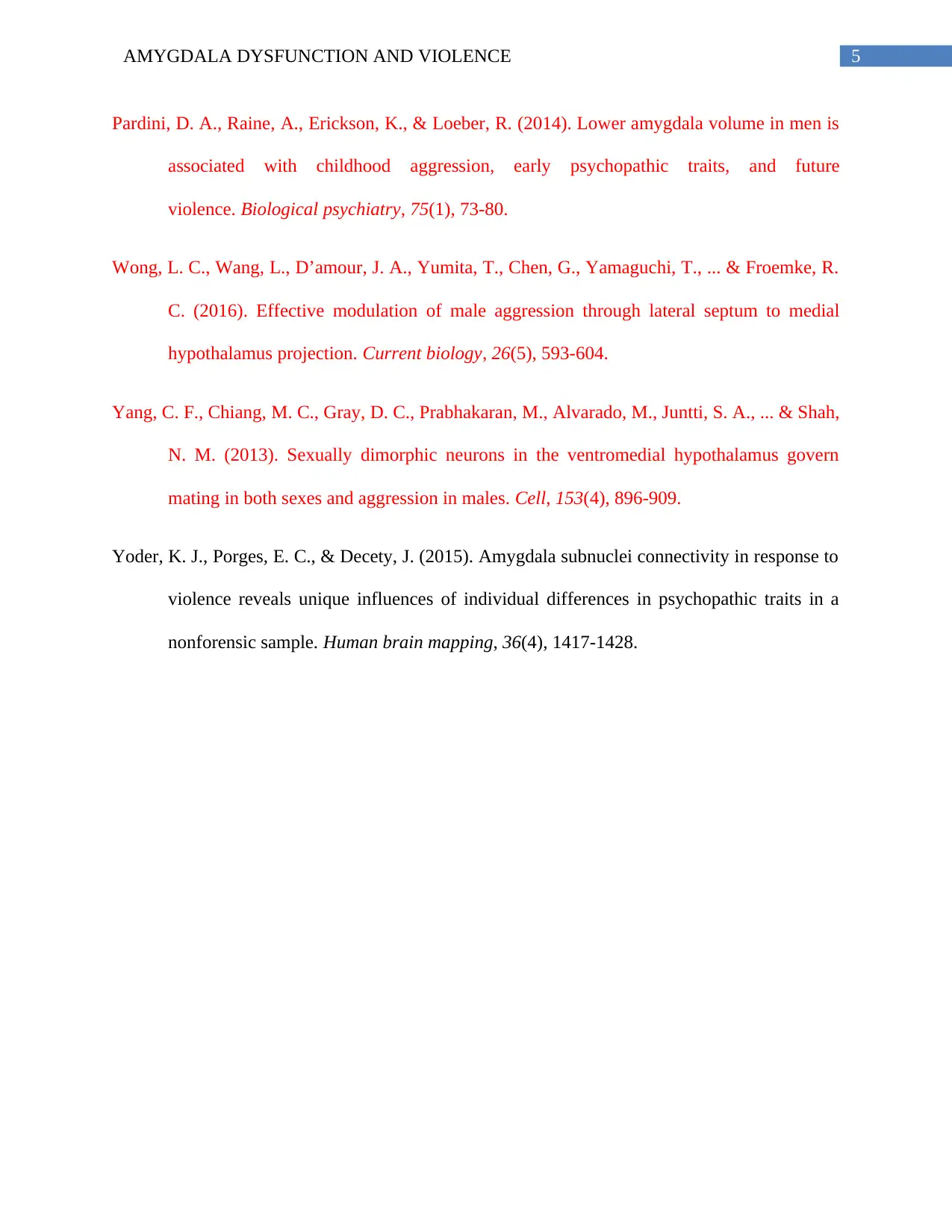
5AMYGDALA DYSFUNCTION AND VIOLENCE
Pardini, D. A., Raine, A., Erickson, K., & Loeber, R. (2014). Lower amygdala volume in men is
associated with childhood aggression, early psychopathic traits, and future
violence. Biological psychiatry, 75(1), 73-80.
Wong, L. C., Wang, L., D’amour, J. A., Yumita, T., Chen, G., Yamaguchi, T., ... & Froemke, R.
C. (2016). Effective modulation of male aggression through lateral septum to medial
hypothalamus projection. Current biology, 26(5), 593-604.
Yang, C. F., Chiang, M. C., Gray, D. C., Prabhakaran, M., Alvarado, M., Juntti, S. A., ... & Shah,
N. M. (2013). Sexually dimorphic neurons in the ventromedial hypothalamus govern
mating in both sexes and aggression in males. Cell, 153(4), 896-909.
Yoder, K. J., Porges, E. C., & Decety, J. (2015). Amygdala subnuclei connectivity in response to
violence reveals unique influences of individual differences in psychopathic traits in a
nonforensic sample. Human brain mapping, 36(4), 1417-1428.
Pardini, D. A., Raine, A., Erickson, K., & Loeber, R. (2014). Lower amygdala volume in men is
associated with childhood aggression, early psychopathic traits, and future
violence. Biological psychiatry, 75(1), 73-80.
Wong, L. C., Wang, L., D’amour, J. A., Yumita, T., Chen, G., Yamaguchi, T., ... & Froemke, R.
C. (2016). Effective modulation of male aggression through lateral septum to medial
hypothalamus projection. Current biology, 26(5), 593-604.
Yang, C. F., Chiang, M. C., Gray, D. C., Prabhakaran, M., Alvarado, M., Juntti, S. A., ... & Shah,
N. M. (2013). Sexually dimorphic neurons in the ventromedial hypothalamus govern
mating in both sexes and aggression in males. Cell, 153(4), 896-909.
Yoder, K. J., Porges, E. C., & Decety, J. (2015). Amygdala subnuclei connectivity in response to
violence reveals unique influences of individual differences in psychopathic traits in a
nonforensic sample. Human brain mapping, 36(4), 1417-1428.
⊘ This is a preview!⊘
Do you want full access?
Subscribe today to unlock all pages.

Trusted by 1+ million students worldwide
1 out of 6